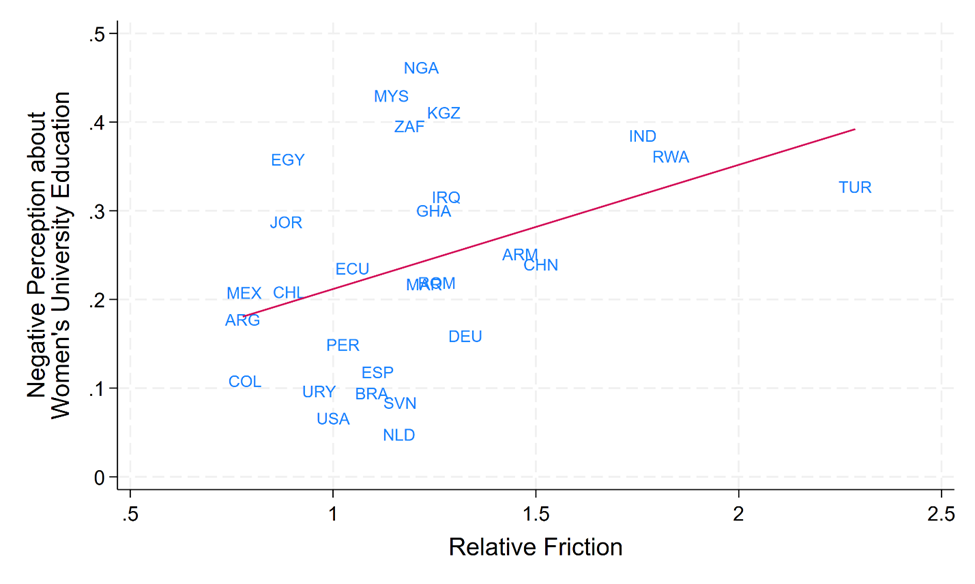
The misallocation of women’s talent, due to barriers to entering non-agricultural work, leads to sizable productivity losses
The disparities in labour productivity between countries have long been a subject of economic inquiry. While these gaps are evident across various industries, they are particularly pronounced in agriculture (Caselli 2005, Restuccia et al. 2008). This phenomenon holds significant implications, especially for developing countries where a substantial portion of the workforce is engaged in agricultural activities.
Disparities in agricultural productivity
The table below reports labour productivity in aggregate, agriculture, and non-agriculture in three high-, medium- and low-income countries: the United States, Indonesia, and Tanzania. The disparities in agricultural productivity are much wider than the disparities in non-agricultural productivity. The ratio of labour productivity between the United States and Tanzania is a factor of 82 in agriculture, while it is a factor of 7 in non-agriculture. In other words, an average farmer in Tanzania produces only 1.2% of what the average US farmer produces. Given that Tanzania’s employment share in agriculture is 66% (ILO 2020), understanding why productivity differences in agriculture are so large is key to understanding world income inequality.

There are several reasons one may be skeptical about the agricultural output and input data underlying these conclusions. However, previous studies using high quality micro-level data for a subset of countries showed that the large disparities in agricultural productivity are real (e.g. Gollin et al. 2014).
A new perspective: Gender disparities
In my research (Lee 2024), I examine the role of gender disparities in shaping agricultural productivity. In many poorer countries, women are disproportionately underrepresented in high-skilled jobs outside of agriculture, reflecting various labour market frictions such as discrimination and barriers to schooling and labour market participation.
The table below reports share of workers that are women in agriculture and non-agriculture in three countries. In the United States, roughly half of workers in non-agriculture are women, while about a quarter of workers in agriculture are women. This reflects women’s comparative advantage in non-agricultural work, while male workers have a comparative advantage in agriculture where physical strength is particularly valued (Pitt et al. 2012). On the other hand, in Tanzania, only 34.5% of workers in non-agriculture are women, while half of workers in agriculture are women.

The figure below plots shares of agricultural workers that are women against the log of real GDP per capita for a sample of 66 countries. The share is negatively correlated with the income of the country. In the developing world, including many sub-Saharan African countries, the shares are above a half. This reflects a misallocation of female talent between the two sectors, which could distort sectoral productivities.

Source: Lee (2024)
Quantitative assessment
To establish the relationship between gender disparities and agricultural productivity, my study develops a theoretical model which incorporates three key elements: variation in workers' sectoral productivities, gender- and sector-specific labour market frictions, and gender-specific labour supply dynamics.
The idea to link gender disparities and agricultural productivity is simple. If women experience higher frictions in non-agricultural versus agricultural industries, then some women who are better skilled at non-agricultural jobs might still choose to work in agriculture. Therefore, agricultural productivity measured by the outcome per worker decreases because of the misallocation of female talent, and the productivity in other industries increases because only women who are sufficiently talented to overcome these frictions enter the workforce in those industries.
By analysing micro-level census data from a sample of 66 countries, the study infers gender- and sector-specific frictions for each country. The findings reveal that countries with higher barriers against women in non-agricultural industries tend to exhibit lower agricultural productivity. This suggests that the misallocation of female talent plays a role in driving the observed productivity differentials.
What is the size of productivity losses coming from the misallocation of female talent in developing world? The model allows me to calculate expected changes in labour productivity when gender- and sector-specific frictions in those countries are reduced to the current US level. The table below reports expected productivity gains and losses in two countries. In Tanzania, its agricultural productivity is expected to grow by 20.8% while non-agricultural productivity is expected to shrink by 5.9%. Note that removing the friction to enter non-agriculture will dampen the positive selection in non-agriculture and push down its productivity. However, the aggregate productivity is expected to grow by 5.5% in Tanzania, so the overall outcome is welfare improving.

Implications
Given sizable productivity losses due to misallocation of female talent, what could policy makers do? The barriers inferred from the model are highly correlated with people’s perceptions about domestic violence, female business executives, women’s university education, women earning more money, female political leaders, and working mothers, as measured in the World Value Survey (2015). For example, the figure below plots negative perceptions about women’s university education against the barriers inferred from the model for 28 countries. Three countries on the right, Turkey (TUR), Rwanda (RWA), and India (IND), show both high negative perception and high barriers. This negative perception acts as a barrier for women to get educated and enter non-agricultural sector in those countries.
 Source: Lee (2024)
Source: Lee (2024)
The recent VoxDevLit on female labour force participation (Heath et al. 2024) discusses various factors affecting women’s decision to participate in the labour force and employers’ decision to hire female workers. The following three factors are the most relevant to the barriers that discourage female workers to enter non-agriculture. First, women typically do the bulk of unpaid childcare work in low-income countries, and this causes women to stay in a small-scale family farms near their home. Childcare provision would allow talented female workers to enter non-agriculture and improve overall productivity. Second, cultural norms shape women’s occupation choices. As previously discussed, negative perceptions about women’s university education, female business executives, and female political leader are higher in low-income countries. Even though it is not easy to change norms and attitudes which are often historically rooted, some early research demonstrates that short-run low-cost interventions that change norms could have larger medium- and long-run effects (e.g. Field et al. 2019). Lastly, women often face fewer chances to get educated through formal schooling and vocational training in low-income countries.
Conclusions
The study provides a new perspective on the large disparities in agricultural productivity across countries, highlighting the significant impact of gender disparities in shaping labour market outcomes. Promoting gender equality is key to inclusive and sustainable economic development, ultimately benefiting individuals and societies worldwide.
References
Caselli, F (2005), "Accounting for Cross-country Income Differences", in P Aghion and S N Durlauf, eds., Handbook of Economic Growth, Vol. 1A, North-Holland, chapter 9, pp. 679–741.
Field, E, R Pande, N Rigol, S Schaner, and C Troyer Moore (2019), "Empowering women through direct digital wage payments", VoxDev.
Gollin, D, D Lagakos, and M Waugh (2014), "Agricultural Productivity Differences across Countries", American Economic Review, 104(5): 165–170.
Heath, R, et al. (2024), "Female Labour Force Participation", VoxDevLit.
International Labour Organization (ILO), "ILO modelled estimates database", ILOSTAT [database]. Available from https://ilostat.ilo.org/data/
Lee, M (2024), "Allocation of Female Talent and Cross-Country Productivity Differences", Economic Journal, accepted.
Pitt, M M, M R Rosenzweig, and M N Hassan (2012), "Human Capital Investment and the Gender Division of Labor in a Brawn-based Economy", American Economic Review, 102(7): 3531–3560.

